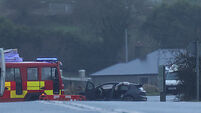Half of heavy goods vehicles found to have roadworthiness defect

HGV drivers are now being urged to carry out daily walk-around checks before undertaking any journey. File picture: Eamonn Farrell/RollingNews.ie
Almost 50% of heavy goods vehicles (HGVs) have been found to have a roadworthiness defect, according to new figures.
Data from the Road Safety Authority (RSA) and An Garda Síochána has found that one in four HGVs surveyed over three years contains a “major defect” such as worn braking components.
The figures come from roadside checks by RSA vehicle inspectors and gardaí between 2018 and 2020. Drivers are now being urged to carry out daily walk-around checks before undertaking any journey.
With 25% of HGVs surveyed in the last three years having major defects, 4% had “dangerous defects” while 20% were found to have "minor defects".
The RSA said an average of 9,500 HGVs were inspected each year over each of the last three years.
They added the most common major defects detected include:
- Faulty lighting systems
- Excessively worn braking components
- Defective anti-lock braking systems which are designed to help drivers maintain steering control in emergency situations.
Paula Hilman, Assistant cCommissioner of An Garda Síochána, said if a driver is convicted of driving a dangerously defective vehicle, they “can expect five penalty points and a fine of up to €5,000”.
She added: “No driver wants to lose their licence and their livelihood so ensure your vehicle is always roadworthy.
“We will continue to work with the RSA in carrying out roadside checks and getting potentially unsafe goods vehicles off our roads.”
Sam Waide, CEO of the RSA, reminded commercial vehicle drivers that they are legally required to ensure a walk-around check of the vehicle is carried out “once in every 24-hour period before it is used on a public road”.
He said that these walk-arounds are “essential in preventing potentially dangerous vehicles”.
Mr Waide added: “The most common dangerous defects detected include excessively worn or damaged tyres and faulty brake lights. Tyres are a vehicle’s only contact with the road and excessively worn or damaged tyres potentially reduce grip and the vehicle’s ability to stop safely.
He said HGV operators need to build “a few simple steps” into their vehicle maintenance regimes.
“This includes carrying out daily walk-around checks and preventative maintenance inspections by suitably qualified personnel at appropriate intervals, bearing in mind the vehicle’s condition, age, and mileage.
“If you do spot a defect, seek advice from a suitably qualified person and do not use the vehicle unless it is safe to do so.”
Mr Waide also urged operators to take the Commercial Vehicle Roadworthiness Test “on time and review your maintenance system regularly to ensure it is fit for purpose.
“Please do not take unnecessary risks on the road – check it, fix it, don’t ignore it.”









